Abstract
Light–heat converters are promising for further development of contact laser surgery. The simplest converter consists of an optical fiber with a strong absorbing layer at the tip. We studied the time dependence of the tip temperature at different CW laser powers and revealed that, in several seconds, the temperature evolution becomes almost power-independent. Mathematical modeling showed that laser ablation of the tip coating is the main reason for this phenomenon.
1. Introduction
An important aspect of oncosurgery efficiency is the choice of an adequate instrument for resection and the method of its application [1]. On the one hand, the selected instrument must comply with the principles of ablastic surgery and, on the other hand, it must allow the operation to be performed quickly enough not to worsen the possibility of further diagnostics of the surgical field. The size of the layer thermally damaged by the laser scalpel is important for creating a bloodless incision. It is important to choose an optimal incision size. The size of the incision depends on the laser resection technique, on the radiation parameters, on the angle of inclination of the scalpel to the surface, etc. Minimization of surgical trauma determines the degree of preservation of the organ function and, thereby, the level of the patient’s quality of life; moreover, the degree of radical removal of the tumor determines the absence of continued growth and/or a relapse of the process.
Non-contact laser surgery has become a classical technique that is described in many textbooks. The peak of its study fell in the 1990s [2,3,4]. It is believed that laser surgery has survived the stage of studying exposure modes and has become a medical technology [5]. Currently, new contact approaches to laser surgery are being developed, one of which is the use of radiation–heat converters [6,7,8,9,10,11]. The simplest example of this kind of scalpel is an optical fiber with a strong absorbing coating (SAC) at the tip. For producing a smooth bloodless seam, the coagulation zone must have a steady size, which is attained if the temperature of the cutting part of the silica fiber is stable. Temperature measurements under cutting conditions are complicated by a small diameter of the fiber (400–550 microns), scattering of the biological tissue, and carbonization of the biological tissue during cutting. Attempts to organize feedback on the radiation power, and thus stabilize the temperature, have not led to clinical use. Recently, there appeared new theoretical models of laser tumor resection [8,9,10], with the help of which it became possible to understand the physical principles of the process and determine optimal radiation parameters.
In this paper, we report on the experimental observation of the effect of temperature stabilization in a stationary radiation–heat converter under atmospheric conditions, when the temperature of the heated layer no longer depends on the laser radiation power. The role of the ablation process in this effect is discussed. From the point of view of the theory of ablation, it is interesting that, due to the geometry of the converter, feedback is established between the removal of matter and the absorption of optical radiation.
2. Materials and Methods
The radiation–heat converter was a silica fiber with a diameter of 550 μm and polymer cladding. The total thickness of the system was approximately 1 mm, with SAC deposited at the tip. A mixture of microparticles of graphite powder and organosilicon varnish was used as an absorbing coating [11,12]. The absorption coefficient of the coating was measured to be 1200 cm−1.
To study the characteristics of the radiation–heat converter, laser radiation was passed through the system and the temperature of the heated body was determined. In our experiments, the converter was immovable. Figure 1 shows a schematic of the experimental setup.

Figure 1.
Schematic of the experimental setup for determining the temperature by the two-color method.
A diode CW laser module with a fiber output was used as a radiation source. The radiation wavelength was approximately 965 nm. The experiments were carried out at average powers from 3 to 6 W. To determine the power, the thermal power sensor head Thorlabs S425C with console PM100D was used.
The temperature was determined by measuring the emission spectrum of the SAC with the OceanOptics QE65Pro spectrometer in the range of 400–800 nm. A short-pass filter was used to filter out the 965 nm laser radiation. An OceanOptics HL2000 calibration lamp was used to calibrate the spectrometer over a wide range of absolute sensitivities. Mathematical conversion of the spectral characteristics to temperature was performed using the Planck formula by the algorithm of the two-color method, which consists of solving the equation for two different wavelengths [12,13]. The most optimal range was the visible wavelength range of 600–750 nm.
SAC was prepared according to the procedure described elsewhere [11,12]. For each series of measurements, the fiber was cleaved, and a new initial coating was deposited. The image of the fiber tip was recorded using a Nikon Eclipse Ci-S optical microscope during the experiment.
3. Results and Discussion
A series of experiments was carried out to study the temperature dynamics in a fixed radiation–heat converter. The radiation–heat converter was supplied with diode laser radiation with powers in the range of 3–6 W. The SAC-coated fiber was heated to a temperature of approximately 2000 K during the absorption of radiation. The time dependence of the SAC temperature is shown in Figure 2.
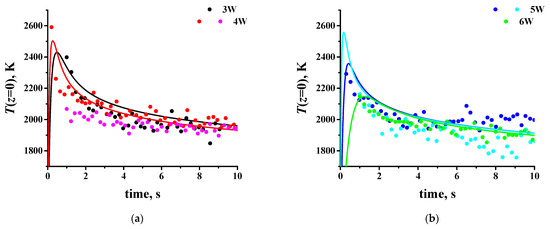
Figure 2.
The dots show the experimentally measured SAC temperature for different laser powers P: (a) 3 W (black) and 4 W (red and magenta); (b) 5 W (blue and cyan) and 6 W (green). For comparison, the curves show the theoretical dependence of the SAC temperature on time, calculated according to the model presented in the text below, for the same values of laser radiation powers.
As follows from the temporal characteristics, at first, in less than 1 s, a sharp increase in temperature to a certain maximum value was observed. Then, in 2–3 s, the temperature decreased to ~2000 K, and, finally, an almost stationary plateau is formed. Contrary to the expectations, an increase in the power of a diode laser did not lead to an increase in the temperature reached in this case. To explain this effect, the following theoretical model was constructed.
Let us consider the problem of heat propagation in an optical fiber with a layer of SAC deposited on the fiber tip. The laser radiation passing through the absorbing layer heats it up, which leads to heating of the optical fiber. In our model, we took into account that the SAC material will evaporate at sufficient heating. A decrease in the SAC thickness leads to a decrease in heating due to the decrease in radiation absorption. Let us calculate how the temperature in the system will change as a result of these processes for different radiation powers.
To solve this problem, we used the following model. In a cylindrical coordinate system (z,r,φ), we considered a semi-infinite cylindrical fiber of radius R, located along the positive direction of the z-axis (see Figure 3). The point r = 0 coincides with the center of the fiber. The fiber tip is located at the point z = 0. The fiber material is assumed to be homogeneous. We assumed that the problem is homogeneous in the azimuthal angle φ. At the point z = 0 of the fiber tip, there is an SAC, the thickness of which is so small that the effect of conversion of laser radiation energy into heat can be taken into consideration upon absorption of light through the boundary condition, as the heat flux into the fiber. This is often done when considering laser heating of metals [14]. We assumed that the substance of the absorbing layer is homogeneous and the layer thickness is the same over the entire area of the fiber tip.
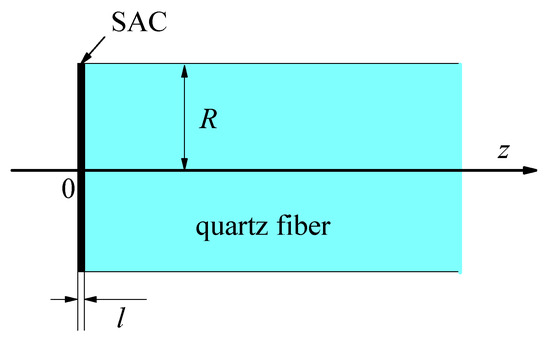
Figure 3.
Schematic of a fiber with an SAC at the tip.
The absorption coefficient of the SAC at the fiber tip at the laser diode radiation wavelength λ = 965 nm was measured to be αSAC = 1200 cm−1. The absorption coefficient of the fiber material was approximately 10−2 cm−1 [15], which is significantly less than the absorption of the SAC material. Therefore, we neglected the absorption of laser radiation directly in the fiber, considering it to be optically transparent.
The temperature distribution T(t,z,r) in a cylindrical coordinate system in the case when the problem is uniform in angle is described by the following diffusion equation:
where cp, ρ, and κ are, respectively, the specific heat at constant pressure, density, and thermal conductivity of silica glass.
We assumed that the condition of an ideal thermal contact between the substance of the absorbing layer and the fiber, i.e., the temperature of the absorbing layer, coincides with the temperature at the fiber tip T(z=0).
The heat exchange with the environment through the side surface of the fiber is described by the equation:
where G is the coefficient of heat transfer between the fiber side surface and the air, and Troom is the room temperature.
Let us introduce the temperature averaged in the transverse direction to the fiber axis:
After averaging over the temperature in the transverse direction in Equation (1) and using Condition (2), we obtain:
Assuming that the temperature changes across the fiber are insignificant and , which implies the relative smallness of the coefficient G, we obtain a one-dimensional equation for the temperature averaged over the transverse coordinate:
At the tip of the fiber, the boundary condition takes into account the heating of the SAC with optical thickness D, when the radiation with intensity I passes through it. Let us also take into account the heat loss due to thermal radiation, assuming that when heated, the absorbing layer radiates as an absolutely black body from both surfaces. Taking into consideration the cooling of the substance during ablation (see, for example, [14] and references therein), as well as the heat exchange with air, we obtain the following boundary condition for the one-dimensional Equation (3):
where σ is the Stefan–Boltzmann constant, ρSAC and μSAC are the density and molar mass of the SAC, respectively, NA is the Avogadro number, kB is the Boltzmann constant, Ta is some characteristic ablation temperature, and ν is the ablation rate.
The optical thickness of the SAC is determined by its absorption coefficient and thickness l:
As the absorbing layer evaporates, its thickness decreases. We assumed that the substance evaporates uniformly and the strongly absorbing layer remains flat with a constant thickness over the entire tip area. The rate of change in thickness is written in the form [14]:
where A0 is a characteristic constant.
As the boundary condition at the other, infinitely distant end of the fiber, we assumed that the temperature is equal to the room temperature Troom. We also took the room temperature of the fiber as the initial condition.
The problem was solved numerically by the sweep (the elimination) method [16] with the transition to a new spatial variable y = 1 − exp(−γ z).
According to [17], the thermal diffusivity of silica glass remains approximately constant up to the ablation temperatures of the substance. Assuming that the thermal conductivity coefficient weakly depends on the changes in temperature allowed us to describe the temperature distribution in the form Equation (3). Then, in the calculations, we assumed that kT is equal to 7.8 cm2/s and does not depend on temperature. The temperature dependence of κ is described in the paper [18].
We assumed that the intensity of laser radiation is uniformly distributed over the fiber tip; then, , where P is the laser diode power.
According to [19], the heat transfer coefficient for a fiber–air pair is G = 5.6 W/(m2⋅K). The room temperature Troom = 300 K. The optical fiber radius is R = 250 µm. The molar density of the substance of the strongly absorbing layer is set to be equal to = 0.2 mol/cm3.
Within the framework of this model, the dependence of SAC temperature on irradiation time was calculated for different laser radiation powers. The curves obtained were compared with the available experimental data (see Figure 2). The comparison took into account that in the course of the experiment, the SAC was deposited anew each time. The initial layer thickness could vary from experiment to experiment. Therefore, the value of the initial optical thickness of the absorbing layer D0 was adjusted so as to ensure the best agreement with the experimental data. In particular, for two experiments with P = 4 W, the value of D0 was the same, due to which the theoretical curves calculated according to the model for the power of 4 W coincided.
The time dependence of the optical thickness of the SAC, calculated according to the above model, is shown in Figure 4.
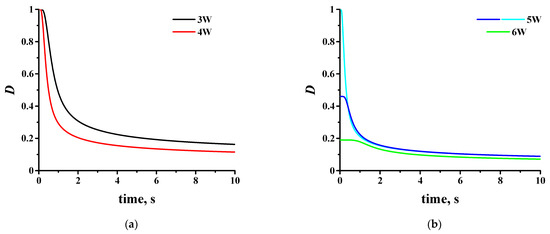
Figure 4.
Time dependence of the optical thickness of SAC calculated using the model for different laser powers P: (a) 3 W (black) and 4 W (red); (b) 5 W (blue and cyan) and 6 W (green).
The comparison of the time dependence of temperature calculated within the framework of the proposed model with the experimental data made it possible to determine the characteristic values of the parameters of the problem: A0 = 2 × 106 cm/s, Ta = 5 × 104 K. The Ta value corresponds to bond energy 4.3 eV, which is an intermediate value between the bond energies of C-C and SiO2.
As can be seen from the data in Figure 2, the radiation power used to heat the fiber tip, as well as the initial thickness of the absorbing layer, have little effect on the temperature of the fiber tip. With an increase in the SAC heating due to an increase in the power of absorbed radiation or an increase in SAC thickness, the substance of the layer begins to evaporate faster. A decrease in the thickness of the absorbing layer, in turn, leads to a reduced heating efficiency and to a decrease in the temperature of the absorbing layer. As a result of this self-regulation process, the temperature of the fiber tip in a few seconds (~5 s) after turning on the laser reaches a value of approximately 2000 K, regardless of the power of the laser radiation or the initial thickness of the absorbing layer.
Let us see how important the role of the ablation process of the SAC in the process of temperature stabilization is. For this, we calculated the change in the temperature of the absorbing layer and its optical thickness in the cases when (1) losses due to radiation and heat exchange with the environment are neglected, while ablation losses are taken into account, and (2) only losses due to radiation and heat exchange with air are taken into consideration in the system, the layer does not evaporate. The calculation results are shown in Figure 5. One can see from the figure that the evaporation of the substance of the absorbing layer plays a fundamental role in the process of temperature stabilization. Radiation and heat transfer do not significantly affect the change in SAC temperature, while in the absence of ablation, the temperature graphs have a fundamentally different character.
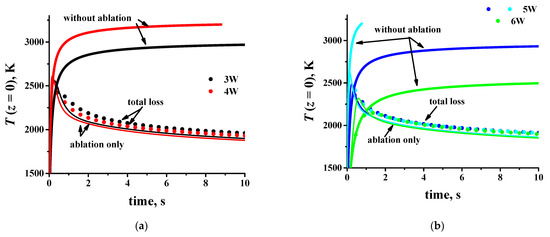
Figure 5.
The change in SAC temperature calculated using the model under the following approximations: Points—all types of losses are taken into account; thin curves—only ablation losses are taken into account; thick curves—only losses due to radiation and heat exchange with the environment are taken into consideration. The laser powers are (a) 3 W (black) and 4 W (red), and (b) 5 W (blue and cyan) and 6 W (green).
The results obtained can be qualitatively explained as follows. As the evaporation rate is highly temperature-dependent, the final temperature sets in so that the corresponding evaporation rate is low. The heat release caused by the laser radiation absorption is proportional to I (1-exp(-D)). Figure 6 shows the time dependence of the product I (1-exp(-D)) for various laser radiation powers when all types of losses (thick curves) are taken into account in the system and when only ablation is taken into consideration (thin curves). As can be seen from the data in the figure, after the temperature has set in, i.e., in ~4–5 s, the value of I (1-exp(-D)) almost does not depend on the laser radiation power P. At small D, (see Equation (4)). Thus, an increase in the laser radiation intensity simply results in a thinner remaining layer (see Figure 2 and Figure 7). In this case, the final thickness does not depend on the initial thickness of the absorbing layer. With a full account of heat losses in the system, the residual thickness of the SAC increases compared to the case when only ablation is taken into consideration.
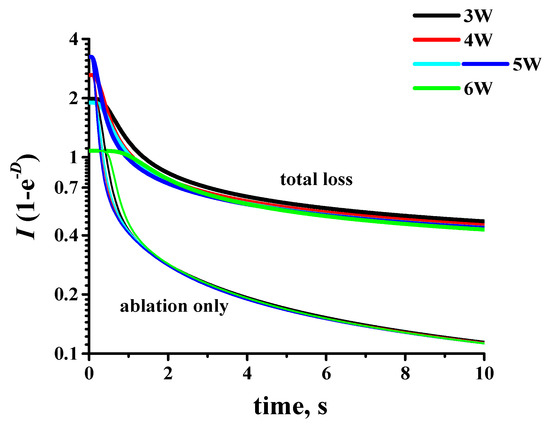
Figure 6.
Time dependence of I (1-exp(-D)) calculated using the model for different laser powers P: 3 W (black), 4 W (red), 5 W (blue and cyan), and 6 W (green). Thick curves correspond to the results when all types of losses in the system are taken into account, and thin curves when only ablation is taken into consideration.
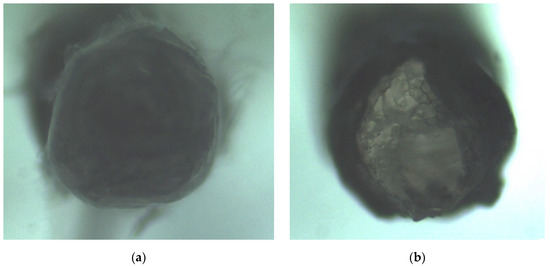
Figure 7.
Image of the tip of a coated fiber (a) before exposure and (b) after exposure for 20 s with a power of 3 W.
In conclusion, we present the results of visual monitoring a fiber tip with a radiation–heat converter based on an SAC layer, which demonstrate how this layer is evaporated (Figure 7).
4. Conclusions
In this work, the time dependence of the temperature of the optical fiber tip with a strongly absorbing coating was studied when the fiber was irradiated by a CW laser with a radiation wavelength of approximately 965 nm. It was found that, in a certain range of laser power, the temperature dynamics weakly depend on the magnitude of this power. In this case, the temperature reaches an almost stationary plateau. Various physical effects that can lead to temperature stabilization were considered, including the heat propagation into the gaseous medium surrounding the fiber and the energy loss due to thermal radiation.
Mathematical modeling of the process showed, however, that the most important effect is laser ablation of the absorbing layer. Laser ablation leads to feedback—the larger the ablated layer, the lower the absorption, which results in stabilization. In this case, the value of the quasi-stationary temperature weakly depends not only on the laser power, but also on the initial thickness of the absorbing layer. As a result, an increase in the radiation power simply leads to a proportional decrease in the remaining absorbing layer.
Author Contributions
Investigation, N.S., V.B., A.A., V.K., N.B.; project administration, V.K.; supervision, N.B.; writing—original draft, N.S.; writing—review and editing, N.B. All authors have read and agreed to the published version of the manuscript.
Funding
This research was supported by the Center of Excellence «Center of Photonics» funded by the Ministry of Science and Higher Education of the Russian Federation, contract no. 075-15-2020-906.
Conflicts of Interest
The authors declare no conflict of interest.
References
- Zeitels, S.M.; Burns, J.A.; Lopez-Guerra, G.; Anderson, R.R.; Hillman, R.E. Photoangiolytic laser treatment of early glottic cancer: A new management strategy. Ann. Otol. Rhinol. Laryngol. 2008, 199, 3–24. [Google Scholar] [CrossRef] [PubMed]
- Jacques, S.L. Laser-tissue interactions: Photochemical, photothermal and photomechanical. Surg. Clin. N. Am. 1992, 72, 531–558. [Google Scholar] [CrossRef]
- Tuchin, V.V. Tissue Optics: Light Scattering Methods and Instruments for Medical Diagnosis; SPIE Press: Washington, DC, USA, 2000; Volume TT38. [Google Scholar]
- Sobol, E.; Serafetinides, A.A.; Makropoulou, M.I.; Helidonis, E.; Kavvalos, G. Hard tissue laser ablation mechanisms. Lasers Med. Sci. 1995, 10, 173–179. [Google Scholar] [CrossRef]
- Freebody, M. Fiber Lasers at the Cutting Edge of Surgery. Biophotonics 2013, 20, 29–32. [Google Scholar]
- Ignatieva, N.Y.; Zakharkina, O.L.; Mazayshvili, C.V.; Bagratashvili, V.N.; Lunin, V.V. Effect of optical fiber type and absorption medium on the endovenous laser ablation mechanism. Appl. Phys. Lett. 2018, 14, 105602. [Google Scholar] [CrossRef]
- Romanos, G.E.; Belikov, A.V.; Skrypnik, A.V.; Feldchtein, F.I.; Smirnov, M.Z.; Altshuler, G.B. Uncovering dental implants using a new Thermo-Optically Powered (TOP) technology with tissue air-cooling. Lasers Surg. Med. 2015, 47, 411–420. [Google Scholar] [CrossRef] [PubMed]
- Sapogova, N.; Bredikhin, V.; Bityurin, N.; Kamensky, V.; Zhigarcov, V.; Yusupov, V. Model for indirect laser surgery. Biomed. Opt. Express 2017, 8, 104–111. [Google Scholar] [CrossRef] [PubMed]
- Chudnovskii, V.M.; Yusupov, V.I.; Dydykin, A.V.; Nevozhai, V.I.; Kisilev, A.Y.; Zhukov, S.A.; Bagratashvili, V.N. Laser-induced boiling of biological liquids in medical technologies. Quantum Electron. 2017, 47, 361–370. [Google Scholar] [CrossRef]
- Belikov, A.V.; Skrypnik, A.V.; Kurnyshev, V.Y.; Shatilova, K.V. Experimental and theoretical study of the heating dynamics of carbon-containing optothermal fibre converters for laser surgery. Quantum Electron. 2016, 46, 534–542. [Google Scholar] [CrossRef]
- Bredikhin, V.; Kamensky, V.; Sapogova, N.; Elagin, V.; Shakhova, M.; Snopova, L.; Bityurin, N. Indirect laser surgery. Appl. Phys. A 2016, 122, 181. [Google Scholar] [CrossRef]
- Bredikhin, V.I. Optothermal properties of a converter of laser radiation to the radiation of a high-temperature point source. Mater. Res. Express 2019, 6, 065412. [Google Scholar] [CrossRef]
- Harding, H.G.W. The colour temperature of light sources. Proc. Phys. Soc. B 1950, 63, 685–698. [Google Scholar] [CrossRef]
- Bäuerle, D.W. Laser Processing and Chemistry; Springer: Berlin/Heidelberg, Germany, 2011. [Google Scholar]
- Elhadj, S.; Matthews, M.J.; Yang, S.T. Combined Infrared Thermal Imaging and Laser Heating for the Study of Materials Thermophysical and Processing Properties at High Temperatures. Crit. Rev. Solid State Mater. Sci. 2014, 39, 175–196. [Google Scholar] [CrossRef]
- Samarskii, A.A. The Theory of Difference Schemes; Marcel Deccer Inc.: New York, NY, USA, 2001; pp. 7–33. [Google Scholar]
- Nowak, K.M.; Baker, H.J.; Hall, D.R. Analytical model for CO2 laser ablation of fused quartz. Appl. Opt. 2015, 54, 8653–8663. [Google Scholar] [CrossRef] [PubMed]
- Yang, S.T.; Matthews, M.J.; Elhadj, S.; Draggoo, V.G.; Bisson, S.E. Thermal transport in CO2 laser irradiated fused silica: In situ measurements and analysis. J. Appl. Phys. 2009, 106, 103106. [Google Scholar] [CrossRef]
- Kuhling, H. Handbook of Physics; Fachbuchverlag: Leipzig, Germany, 1965. [Google Scholar]
Publisher’s Note: MDPI stays neutral with regard to jurisdictional claims in published maps and institutional affiliations. |
© 2021 by the authors. Licensee MDPI, Basel, Switzerland. This article is an open access article distributed under the terms and conditions of the Creative Commons Attribution (CC BY) license (https://creativecommons.org/licenses/by/4.0/).